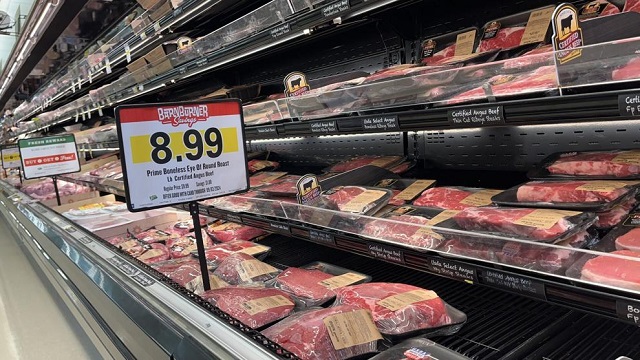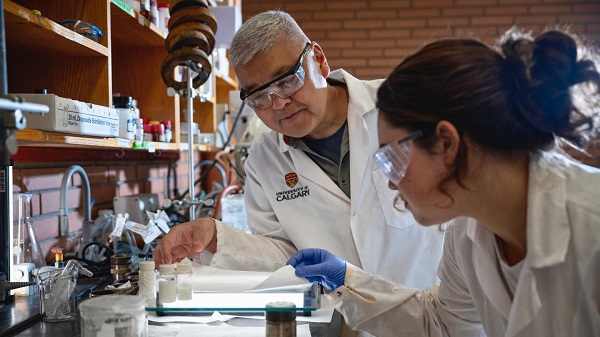Business
FACT CHECK: Who’s to blame for high grocery, energy, other costs?

From The Center Square
By
With inflationary costs reaching a 40-year high under the Biden-Harris administration, President Joe Biden, Vice President Kamala Harris and others in their administration have repeatedly blamed businesses, livestock producers, grocery stores, oil and natural gas companies and others for high prices.
At the same time, a record number of businesses closed, declared bankruptcy and laid off hundreds of thousands of workers, citing high inflationary costs. In a recent report, nearly half of all small businesses said they won’t survive a second Harris term, higher costs and increased taxes, The Center Square reported.
Despite this, Harris says she plans to implement price controls, increase taxes on businesses and allow the 2017 tax cuts to expire, creating a $6 trillion chasm between her plan and former President Donald Trump’s, the Wall Street Journal reported.
As Americans struggled with increased grocery costs, including the high cost of meat, producers were faced with higher fuel, feed, grain and hay costs, driving up their operational costs that were passed onto consumers, according to multiple reports. In response, in 2021, the White House National Economic Council blamed high meat prices on “dominant corporations in uncompetitive markets taking advantage of their market power.”
The U.S. Chamber of Commerce disagrees, arguing that market concentration in the meat packing industry had been virtually unchanged for 25 years at the time. It then asked “if high prices are the result of corporate greed, why did these ‘greedy’ companies wait two decades to raise prices?” It clarified that increased meat prices were driven by supply and demand and overall inflation, largely created by increased federal spending and debt.
With costs increasing across the board, some companies adjusted by selling less product for more, referred to as shrinkflation, The Center Square first reported in 2022. However, Biden and Harris blamed companies for higher costs, reportedly in response to Democratic operatives advising them to do so, The Washington Post reported.
“What we said is, ‘You need a villain or an explanation for this. If you don’t provide one, voters will fill one in. The right is providing an explanation, which is that you’re spending too much,’” one Democratic operative told the Post. “That point finally became convincing to people in the White House.”
“And thus began the effort to wrongly blame employers for high prices,” the chamber’s executive vice president Neil Bradley said in a report identifying examples of the White House “wrongly blaming businesses for high prices.”
Also in 2022, Biden publicly blamed container companies for high shipping costs. News reports pointed to supply chain issues impacted by worker shortages, changes in customer spending that resulted in more cargo arriving in ports that the ports couldn’t handle, and port fines and fees contributing to higher costs.
The chamber notes that increased prices “resulted from consumers shifting their spending from services to goods” during the COVID-lockdown era, causing increased cargo demand. “Increased demand created backlogs at the ports, raising prices even higher. As supply and demand normalized, prices fell.”
By 2023, the president again publicly blamed the U.S. oil and natural gas industry for gas prices reaching a seven-year high. This was after he took more than 200 actions against the U.S. oil and natural gas industry, U.S. House Democrats introduced a bill that would have added a 50% per barrel tax, and the U.S. Treasury Department proposed a $110 billion tax hike on the industry, The Center Square reported.
But the industry doesn’t control the market, it’s subject to it like everyone else, Texas Independent Producers & Royalty Owners Association President Ed Longanecker said. The Biden-Harris administration could have lowered costs by expediting permits, lifting the federal leasing ban and creating “a more stable regulatory environment that provides certainty to producers and investors,” he told The Center Square. “Overburdensome regulations, increased taxes and anti-oil and natural gas rhetoric” exacerbated high energy prices and raised consumer costs, he said.
The administration has also repeatedly sued the industry and Texas, which leads U.S. production, exports and energy creation. In response, Texas Gov. Greg Abbott has aggressively fought to protect the Texas industry from Biden policies, the governor argues.
Also in 2023, the chair of Biden’s Council of Economic Advisers said grocery sector profit margins “were elevated” and needed to “pass-through” to consumers. Earlier this year, Biden again claimed, “there are still too many corporations in America ripping people off: price gouging, junk fees, greedflation, shrinkflation.”
The chamber refutes these claims, pointing to federal data, arguing that “higher grocery prices are a result of inflationary pressure across the supply chain and basic supply and demand dynamics,” explained by Department of Agriculture and Government Accountability Office economists.
Biden and Harris blaming businesses for high prices is “entirely backward,” Bradley says. “The truth is the Administration’s own fiscal and regulatory policies are driving inflation, and the American consumer is left holding the bag.”
Business
Canada’s economic performance cratered after Ottawa pivoted to the ‘green’ economy

From the Fraser Institute
By Jason Clemens and Jake Fuss
There are ostensibly two approaches to economic growth from a government policy perspective. The first is to create the best environment possible for entrepreneurs, business owners and investors by ensuring effective government that only does what’s needed, maintains competitive taxes and reasonable regulations. It doesn’t try to pick winners and losers but rather introduces policies to create a positive environment for all businesses to succeed.
The alternative is for the government to take an active role in picking winners and losers through taxes, spending and regulations. The idea here is that a government can promote certain companies and industries (as part of a larger “industrial policy”) better than allowing the market—that is, individual entrepreneurs, businesses and investors—to make those decisions.
It’s never purely one or the other but governments tend to generally favour one approach. The Trudeau era represented a marked break from the consensus that existed for more than two decades prior. Trudeau’s Ottawa introduced a series of tax measures, spending initiatives and regulations to actively constrain the traditional energy sector while promoting what the government termed the “green” economy.
The scope and cost of the policies introduced to actively pick winners and losers is hard to imagine given its breadth. Direct spending on the “green” economy by the federal government increased from $600 million the year before Trudeau took office (2014/15) to $23.0 billion last year (2024/25).
Ottawa introduced regulations to make it harder to build traditional energy projects (Bill C-69), banned tankers carrying Canadian oil from the northwest coast of British Columbia (Bill C-48), proposed an emissions cap on the oil and gas sector, cancelled pipeline developments, mandated almost all new vehicles sold in Canada to be zero-emission by 2035, imposed new homebuilding regulations for energy efficiency, changed fuel standards, and the list goes on and on.
Despite the mountain of federal spending and regulations, which were augmented by additional spending and regulations by various provincial governments, the Canadian economy has not been transformed over the last decade, but we have suffered marked economic costs.
Consider the share of the total economy in 2014 linked with the “green” sector, a term used by Statistics Canada in its measurement of economic output, was 3.1 per cent. In 2023, the green economy represented 3.6 per cent of the Canadian economy, not even a full one-percentage point increase despite the spending and regulating.
And Ottawa’s initiatives did not deliver the green jobs promised. From 2014 to 2023, only 68,000 jobs were created in the entire green sector, and the sector now represents less than 2 per cent of total employment.
Canada’s economic performance cratered in line with this new approach to economic growth. Simply put, rather than delivering the promised prosperity, it delivered economic stagnation. Consider that Canadian living standards, as measured by per-person GDP, were lower as of the second quarter of 2025 compared to six years ago. In other words, we’re poorer today than we were six years ago. In contrast, U.S. per-person GDP grew by 11.0 per cent during the same period.
Median wages (midpoint where half of individuals earn more, and half earn less) in every Canadian province are now lower than comparable median wages in every U.S. state. Read that again—our richest provinces now have lower median wages than the poorest U.S. states.
A significant part of the explanation for Canada’s poor performance is the collapse of private business investment. Simply put, businesses didn’t invest much in Canada, particularly when compared to the United States, and this was all pre-Trump tariffs. Canada’s fundamentals and the general business environment were simply not conducive to private-sector investment.
These results stand in stark contrast to the prosperity enjoyed by Canadians during the Chrétien to Harper years when the focus wasn’t on Ottawa picking winners and losers but rather trying to establish the most competitive environment possible to attract and retain entrepreneurs, businesses, investors and high-skilled professionals. The policies that dominated this period are the antithesis of those in place now: balanced budgets, smaller but more effective government spending, lower and competitive taxes, and smart regulations.
As the Carney government prepares to present its first budget to the Canadian people, many questions remain about whether there will be a genuine break from the policies of the Trudeau government or whether it will simply be the same old same old but dressed up in new language and fancy terms. History clearly tells us that when governments try to pick winners and losers, the strategy doesn’t lead to prosperity but rather stagnation. Let’s all hope our new prime minister knows his history and has learned its lessons.
Business
Canadians paid $90 billion in government debt interest in 2024/25

From the Fraser Institute
By Jake Fuss, Tegan Hill and William Dunstan
Next week, the Carney government will table its long-awaited first budget. Earlier this year, Prime Minister Mark Carney launched a federal spending review to find $25 billion in savings by 2028. Even if the government meets this goal, it won’t be enough to eliminate the federal deficit—projected to reach as high as $92.2 billion in 2025/26—and start paying down debt. That means a substantial amount of taxpayer dollars will continue to flow towards federal debt interest payments, rather than programs and services or tax relief for Canadians.
When a government spends more than it raises in revenue and runs a budget deficit, it accumulates debt. As of 2024/25, the federal and provincial governments will have accumulated a total projected $2.3 trillion in combined net debt (total debt minus financial assets).
Of course, like households, governments must pay interest on their debt. According to our recent study, the provinces and federal government expect to spend a combined $92.5 billion on debt interest payments in 2024/25.
And like any government spending, taxpayers fund these debt interest payments. The difference is that instead of funding important programs, such as health care, these taxpayer dollars will finance government debt. This is the cost of deficit spending.
How much do Canadians pay each year in government debt interest costs? On a per-person basis, combined provincial and federal debt interest costs in 2024/25 are expected to range from $1,937 in Alberta to $3,432 in Newfoundland and Labrador. These figures represent provincial debt interest costs, plus the federal portion allocated to each province based on a five-year average (2020-2024) of their share of Canada’s population.
For perspective, it’s helpful to compare debt interest payments to other budget items. For instance, the federal government estimates that in 2024/25 it will spend more on debt interest costs ($53.8 billion) than on child-care benefits ($35.1 billion) or the Canada Health Transfer ($52.1 billion), which supports provincial health-care systems.
Provincial governments too spend more money on interest payments than on large programs. For example, in 2024/25, Ontario expects to spend more on debt interest payments ($15.2 billion) than on post-secondary education ($14.2 billion). That same year, British Columbia expects to spend more on debt interest payments ($4.4 billion) than on child welfare ($4.3 billion).
Unlike other forms of spending, governments cannot simply decide to spend less on debt interest payments in a given year. To lower their debt interest payments, governments must rein in spending and eliminate deficits so they can start to pay down debt.
Unfortunately, most governments in Canada are doing the opposite. All but one province (Saskatchewan) plans to run a deficit in 2025/26 while the federal deficit could exceed $90 billion.
To stop racking up debt, governments must balance their budgets. By spending less today, governments can ensure that a larger share of tax dollars go towards programs or tax relief to benefit Canadians rather than simply financing government debt.
-

 Alberta11 hours ago
Alberta11 hours agoFrom Underdog to Top Broodmare
-

 National2 days ago
National2 days agoCanada’s NDP is now calling women ‘non-males’
-

 Alberta2 days ago
Alberta2 days agoNobel Prize nods to Alberta innovation in carbon capture
-

 International22 hours ago
International22 hours agoPrince Andrew banished from the British monarchy
-

 Business22 hours ago
Business22 hours ago“We have a deal”: Trump, Xi strike breakthrough on trade and fentanyl
-

 MxM News2 days ago
MxM News2 days agoTrump ‘Grateful’ For Bill Gates Pivot, Declares Victory Over ‘Climate Change Hoax’
-

 Business1 day ago
Business1 day agoCanada’s attack on religious charities makes no fiscal sense
-

 Crime22 hours ago
Crime22 hours agoCanada Seizes 4,300 Litres of Chinese Drug Precursors Amid Trump’s Tariff Pressure Over Fentanyl Flows











